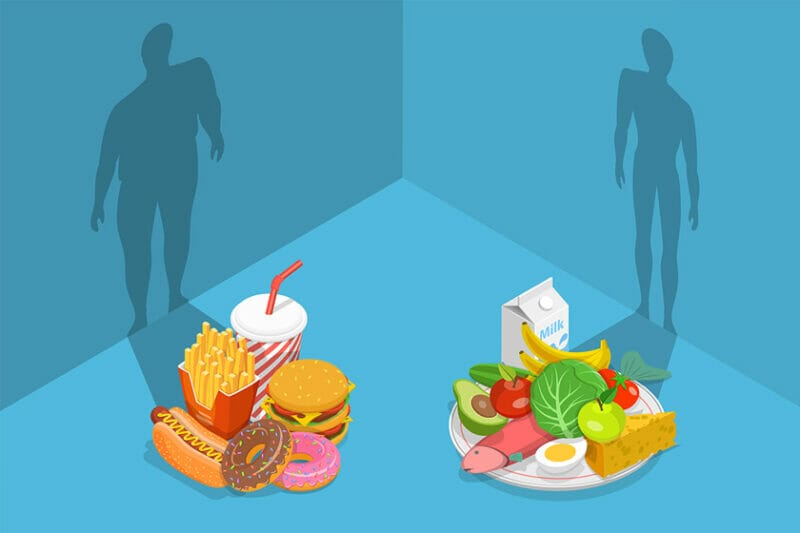
For many years the perceived understanding/dogma has been, and remains to a large extent, embedded in the comprehension that all consumed calories derived from food/drink are equal.
Just to revisit the definition of what a calorie is – Calories are a measure of energy. “Small” calories (cal) estimate the amount of energy required to raise the temperature of exactly one gram of water by one degree Celsius at one atmospheric pressure, and “big” calories, also known as kilogram calories (Cal), are more commonly known and refer to the calories in food.
Isocaloric vs Isometabolic
The big calorie is so named because it is equivalent to 1000 of the small calories (1 kilocalorie). Caloric intake is of course not solely about quantity. The quality of the caloric intake is vital as well. Just because all foods in equal amounts may be isocaloric, this does not mean that they are all isometabolic. When comparing foods, an equal number of calories does not mean that the foods will affect the body in the same way.
Daily caloric intake can be calculated, and is influenced by various factors, including gender, height, weight, activity level, microbiota, and age. A study published in the journal Nature Communications, has helped to further understand the impact of the bacteria in our gut on the conversion of the caloric content of the food eaten[1]. The body reacts differently to calories ingested from high-fibre whole foods vs. ultra-processed junk foods[2].
Processed Vs Unprocessed Foods
The term ultra-processed foods is usually based on a food classification method called NOVA which defines ultra-processed foods as those made by industrial processing and containing additives such as colours, flavours, emulsifiers, free sugars, hydrogenated fats and salt or preservatives.
An article in the British Medical Journal (BMJ) found that ultra-processed foods account for 56.8% of total energy intake and 64.7% of total free sugars in the UK diet. Free sugars represent 12.4% of total energy intake, and 61.3% of the sample exceeded the recommended limit of 10% energy from free sugars[3]. A depressing indication of the dominance of the large food industrial producers over the generation of food using natural unprocessed ingredients.

When we hear from some in politics the term ‘nanny state’ relating to the resistance to the marketing of these nutrient-deficient food or the resistance to discontinuing ‘buy one get one free’, you know they are being lobbied by the food industry. If there was a genuine interest in helping people afford food, then the discounting should be applied to fruits, vegetables and other fibrous foods.
It is all about Fibre
Fibre you see is absent in any material significance in ultra-processed foods, which means when they are consumed their ingredients are more quickly absorbed in the upper GI directing the energy to human cells, rather than the fibre-loving microbiome that occupies the colon.
Feeding the colonic bacteria is an effective way of reducing overall caloric absorption, but also facilitates the creation of many secondary and beneficial compounds that enhance health, rather than degrading it. These include short-chain fatty acids and increased levels of hormones such as GLP-1, which promotes satiety. (The new popular diabetes and weight loss drugs, Ozempic and Wegovy, work by mimicking the action of GLP-1.)
Of course, the relationships among diet composition, gut microbes, and colonic transit time are complex, multi-directional, and vary within individuals over time and between individuals. However, the main understanding is that the more fermentation of fibre and their associated metabolic outputs there are, the energy transferred from the food to the host is reduced – in effect, fibre benefits health generation and limits weight gain when comparing ultra-processed food calories to unprocessed food calories1.
Suggestions
Metabolic control of our bodies is comprehensively disrupted when we ingest ultra-processed foods, and for many, these make up the majority of their daily caloric intake. The consequences are profound, weight control in the UK is increasingly difficult and the food industry is a primary driver of the systemic impact on economic and personal activity compression that comes with weight and metabolic-related health challenges.
Fibre is a subject quick to induce eye rolls, as for many, they associate this with indigestible extracted food components rather than the fruits, vegetables, pulses and grains best suited to deliver the related benefits[4]. When starting to transition from a Western style diet to one that is more aligned with the Mediterranean diet, some people may find that their colonic fermentation rates become uncomfortable. Super green foods prepared with multiple nutrients as well as probiotics can facilitate this transfer and assist with the increased availability of essential nutrients excluded from the ultra-processed food choices.
References
[1] Corbin, K.D., Carnero, E.A., Dirks, B. et al. Host-diet-gut microbiome interactions influence human energy balance: a randomized clinical trial. Nat Commun 14, 3161 (2023)
[2] Cani, P.D., Van Hul, M., Lefort, C. et al. Microbial regulation of organismal energy homeostasis. Nat Metab 1, 34–46 (2019).
[3] Rauber F, Louzada MLDC, Martinez Steele E, et al Ultra-processed foods and excessive free sugar intake in the UK: a nationally representative cross-sectional study BMJ Open 2019;9:e027546.
[4] Ioniță-Mîndrican CB, Ziani K, Mititelu M, Oprea E, Neacșu SM, Moroșan E, Dumitrescu DE, Roșca AC, Drăgănescu D, Negrei C. Therapeutic Benefits and Dietary Restrictions of Fiber Intake: A State of the Art Review. Nutrients. 2022 Jun 26;14(13):2641.
